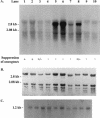Translation start sequences affect the efficiency of silencing of Agrobacterium tumefaciens T-DNA oncogenes
- PMID: 12972655
- PMCID: PMC281594
- DOI: 10.1104/pp.103.026534
Translation start sequences affect the efficiency of silencing of Agrobacterium tumefaciens T-DNA oncogenes
Abstract
Agrobacterium tumefaciens oncogenes cause transformed plant cells to overproduce auxin and cytokinin. Two oncogenes encode enzymes that convert tryptophan to indole-3-acetic acid (auxin): iaaM (tryptophan mono-oxygenase) and iaaH (indole-3-acetamide hydrolase). A third oncogene (ipt) encodes AMP isopentenyl transferase, which produces cytokinin (isopentenyl-AMP). Inactivation of ipt and iaaM (or iaaH) abolishes tumorigenesis. Because adequate means do not exist to control crown gall, we created resistant plants by introducing transgenes designed to elicit posttranscriptional gene silencing (PTGS) of iaaM and ipt. Transgenes that elicit silencing trigger sequence-specific destruction of the inducing RNA and messenger RNAs with related sequences. Although PTGS has proven effective against a variety of target genes, we found that a much higher percentage of transgenic lines silenced iaaM than ipt, suggesting that transgene sequences influenced the effectiveness of PTGS. Sequences required for oncogene silencing included a translation start site. A transgene encoding a translatable sense-strand RNA from the 5' end of iaaM silenced the iaaM oncogene, but deletion of the translation start site abolished the ability of the transgene to silence iaaM. Silencing A. tumefaciens T-DNA oncogenes is a new and effective method to produce plants resistant to crown gall disease.
Figures








Similar articles
-
Silencing Agrobacterium oncogenes in transgenic grapevine results in strain-specific crown gall resistance.Plant Cell Rep. 2013 Nov;32(11):1751-7. doi: 10.1007/s00299-013-1488-0. Epub 2013 Aug 1. Plant Cell Rep. 2013. PMID: 23903949
-
Regulation of oncogene expression in T-DNA-transformed host plant cells.PLoS Pathog. 2015 Jan 23;11(1):e1004620. doi: 10.1371/journal.ppat.1004620. eCollection 2015 Jan. PLoS Pathog. 2015. PMID: 25615824 Free PMC article.
-
Silencing of Agrobacterium tumefaciens oncogenes ipt and iaaM induces resistance to crown gall disease in plum but not in apricot.Pest Manag Sci. 2017 Oct;73(10):2163-2173. doi: 10.1002/ps.4600. Epub 2017 Jun 13. Pest Manag Sci. 2017. PMID: 28449201
-
The Agrobacterium Phenotypic Plasticity (Plast) Genes.Curr Top Microbiol Immunol. 2018;418:375-419. doi: 10.1007/82_2018_93. Curr Top Microbiol Immunol. 2018. PMID: 29770865 Review.
-
Agrobacterium tumefaciens and the plant: the David and Goliath of modern genetics.Plant Physiol. 2003 Nov;133(3):948-55. doi: 10.1104/pp.103.032243. Plant Physiol. 2003. PMID: 14612581 Free PMC article. Review. No abstract available.
Cited by
-
Cloning, expression, purification and crystallization of dihydrodipicolinate synthase from Agrobacterium tumefaciens.Acta Crystallogr Sect F Struct Biol Cryst Commun. 2012 Sep 1;68(Pt 9):1040-7. doi: 10.1107/S1744309112033052. Epub 2012 Aug 30. Acta Crystallogr Sect F Struct Biol Cryst Commun. 2012. PMID: 22949190 Free PMC article.
-
Salicylic acid and systemic acquired resistance play a role in attenuating crown gall disease caused by Agrobacterium tumefaciens.Plant Physiol. 2008 Feb;146(2):703-15. doi: 10.1104/pp.107.111302. Epub 2007 Dec 21. Plant Physiol. 2008. PMID: 18156296 Free PMC article.
-
Silencing Agrobacterium oncogenes in transgenic grapevine results in strain-specific crown gall resistance.Plant Cell Rep. 2013 Nov;32(11):1751-7. doi: 10.1007/s00299-013-1488-0. Epub 2013 Aug 1. Plant Cell Rep. 2013. PMID: 23903949
-
Reciprocal chromosome translocation associated with TDNA-insertion mutation in Arabidopsis: genetic and cytological analyses of consequences for gametophyte development and for construction of doubly mutant lines.Planta. 2009 Mar;229(4):731-45. doi: 10.1007/s00425-008-0868-0. Epub 2008 Dec 12. Planta. 2009. PMID: 19082841 Free PMC article.
-
1-(4-Amino-2-Hydroxyphenyl)Ethenone Suppresses Agrobacterium tumefaciens Virulence and Metabolism.Front Microbiol. 2020 Nov 12;11:584767. doi: 10.3389/fmicb.2020.584767. eCollection 2020. Front Microbiol. 2020. PMID: 33281779 Free PMC article.
References
Publication types
MeSH terms
Substances
LinkOut - more resources
Full Text Sources
Other Literature Sources

